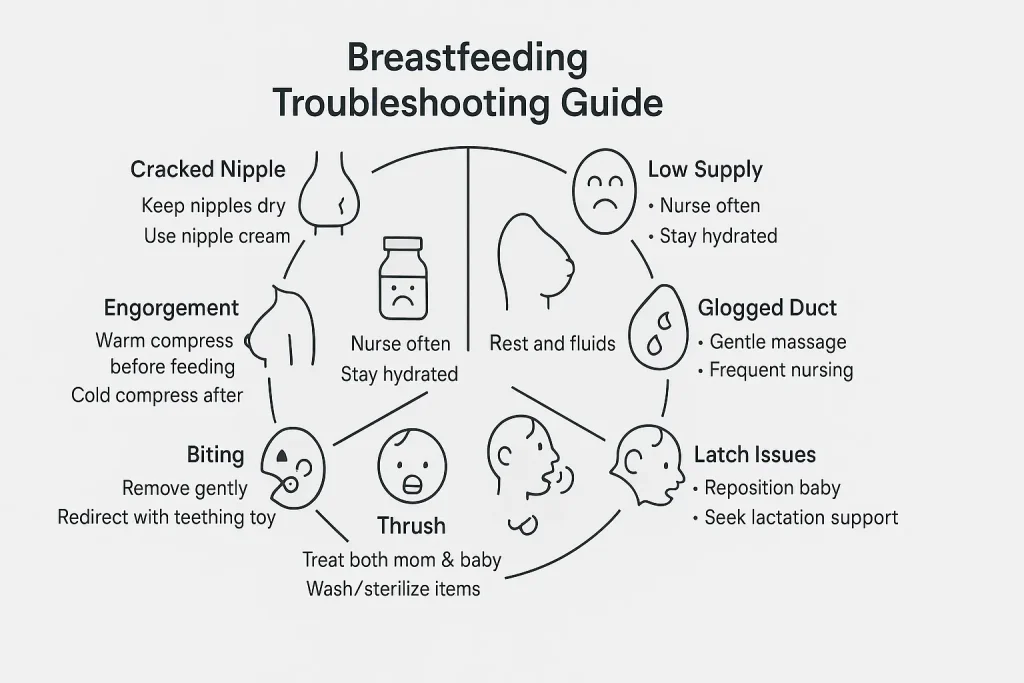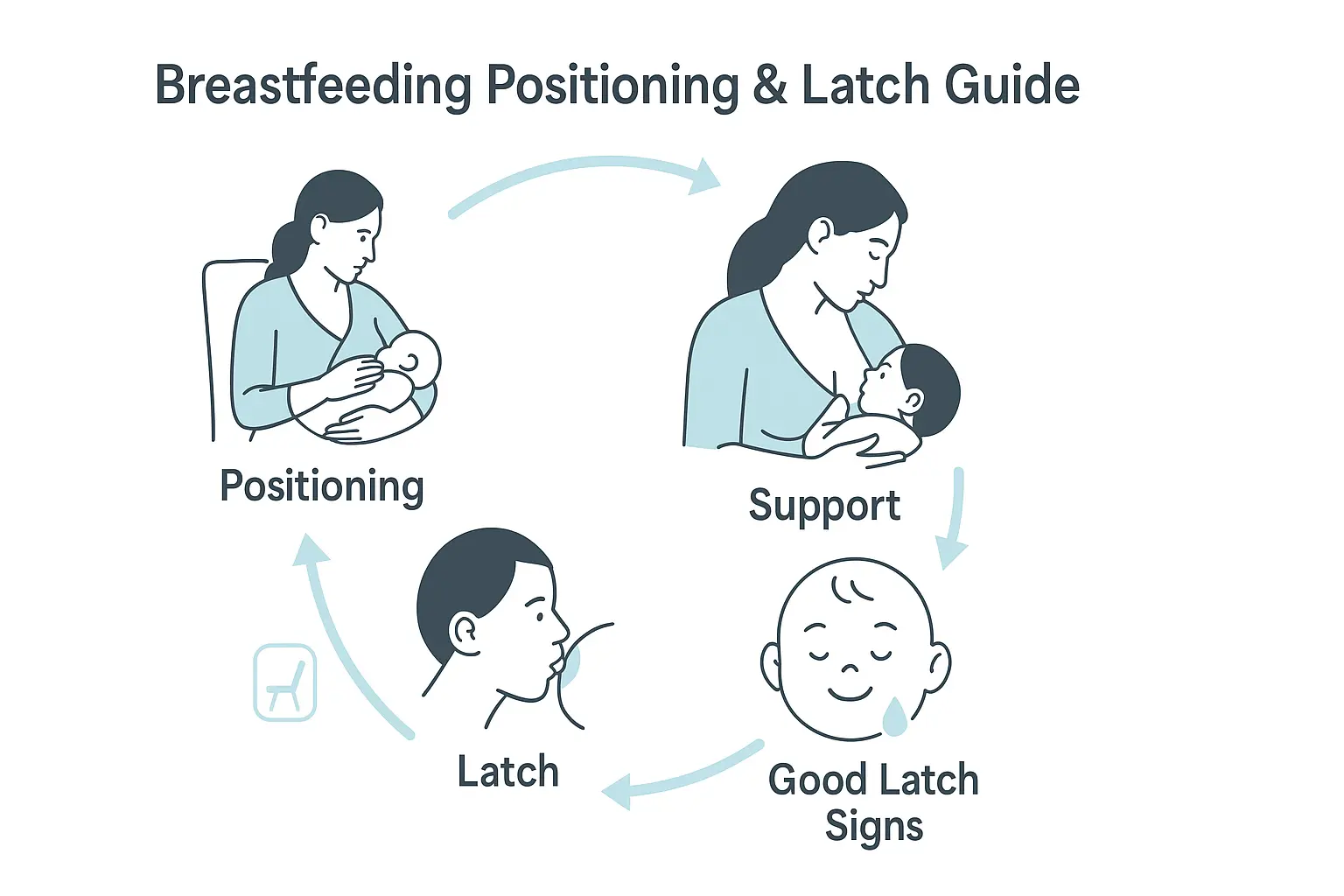In summary, this guide has addressed nine of the most common challenges that new mothers face on their breastfeeding journey, providing expert-approved, practical solutions for each. We have walked through everything from the physical discomfort of sore nipples and painful engorgement to the deep-seated anxiety surrounding low milk supply, offering clear explanations of why these problems occur and actionable steps you can take to resolve them.
The core message is that while breastfeeding is natural, it is a learned skill for both you and your baby, and encountering bumps along the road is not a sign of failure but a normal part of the process.
The most crucial takeaway is that you should never have to struggle through these challenges alone. While the tips provided can offer immediate relief and guidance for many common breastfeeding problems and solutions, the support of a professional can be transformative.
This article is intended to be your first line of support, but it also highlights the immense value of personalised, hands-on help. Seeking guidance from the best lactation consultant at a dedicated breastfeeding support clinic is a proactive step towards building a confident, joyful, and successful breastfeeding relationship with your baby.
Introduction
Breastfeeding is often described as the most natural thing in the world, but for so many new mothers, it doesn’t always feel that way.
If you are finding your breastfeeding journey more challenging than you expected, please hear this first: you are not alone, and you are doing an amazing job. It’s a learned skill for both you and your baby, and almost every mother faces a few hurdles along the way.
At Borneo Hospitals, our postnatal care team, including our expert obstetricians like Dr. Vrushali Pillai, and our dedicated lactation supporters, wants to provide you with the reassurance and practical advice you need.
This guide is your first stop for help. We will walk you through nine of the most common breastfeeding problems and solutions, helping you troubleshoot at home. And if you need more support, our team and the best lactation consultants are here for you.
Before We Start: Be Kind to Yourself
Remember that your body has just done something incredible. Be patient with yourself and your baby as you both learn this new dance. A little bit of pareshani (trouble) is normal.
9 Common Breastfeeding Problems & Their Solutions
Problem 1: Sore, Painful, or Cracked Nipples
This is one of the most common complaints.
Why it Happens:
The number one cause is a shallow latch, where the baby is sucking on just the nipple instead of taking a large mouthful of the breast.
The Solution:
- Check the Latch: Aim for an asymmetric latch. Your baby’s mouth should be wide open (like a yawn), with their lips flanged out. More of the areola should be visible above their top lip than below.
- Soothing Care: After feeding, express a little breast milk and let it air-dry on your nipples. Use a purified lanolin cream between feeds.
Problem 2: "I Don't Think I Have Enough Milk!" (Low Milk Supply)
This is a huge source of anxiety for new mothers.
Why it Happens:
Often, this is a perceived problem rather than a real one. If your baby is gaining weight well and has enough wet and dirty diapers, your supply is likely fine. True low supply can be caused by not breastfeeding often enough, certain medications, or hormonal issues.
The Solution:
- Feed on Demand: The more you feed, the more milk your body makes. It’s a supply-and-demand system.
- How to increase breast milk supply naturally: Ensure you are eating and drinking enough. Many Indian mothers find gharelu nuskhe (home remedies) like including fenugreek (methi), fennel (saunf), and oats in their diet to be helpful.
- Pump After Feeds: Pumping for 10-15 minutes after some feeds can signal your body to produce more milk.
Problem 3: Painful, Hard, and Swollen Breasts (Engorgement)
This usually happens in the first week when your milk first comes in.
Why it Happens:
Your body is figuring out how much milk to make, and sometimes it makes too much at first, leading to swelling.
The Solution:
- Feed Frequently: The best way to relieve the pressure is to empty the breasts.
- Gentle Massage & Warm Compress: Before feeding, use a warm compress and gently massage the breast to help the milk flow.
- Cold Compress: After feeding, use a cold compress (like a bag of frozen peas wrapped in a towel) to reduce swelling.

Problem 4: Difficulty Latching
Why it Happens:
It can be due to the baby’s position, a sleepy baby, or sometimes conditions like a tongue-tie.
The Solution:
- Try Different Positions: Experiment with the cradle, cross-cradle, or rugby hold positions.
- Skin-to-Skin: Holding your baby skin-to-skin can help relax them and encourage their natural feeding instincts.
- Get Help: This is a perfect reason to visit a breastfeeding support clinic.
Problem 5: A Hard, Painful Lump in the Breast (Clogged Duct)
Why it Happens:
A milk duct can become blocked if the breast isn’t drained effectively.
The Solution:
- Heat, Massage, Empty: The mantra is heat (warm compress), massage the lump gently towards the nipple, and then empty the breast by feeding or pumping.
- Dangle Feeding: Leaning over your baby so gravity can help drain the duct can be effective.
Problem 6: My Baby is Always Falling Asleep at the Breast
Why it Happens:
This is very common in newborns. They are sleepy, and the comfort of breastfeeding lulls them to sleep.
The Solution:
- Breast Compression: When you notice their sucking slows down, gently squeeze your breast to increase the milk flow and encourage them to keep swallowing.
- Switch Sides: As soon as they get sleepy on one side, switch them to the other.
Problem 7: Mastitis (A Painful Breast Infection)
Why it Happens:
An unresolved clogged duct can sometimes lead to an infection. You may have a red, wedge-shaped area on your breast and feel flu-like symptoms.
The Solution:
- Call Your Doctor: You will likely need antibiotics. It is very important to get this checked.
- Keep Feeding: It is safe and essential to continue breastfeeding from the affected breast to help clear the infection.
Problem 8: Baby is Fussy or Gassy After Feeds
Why it Happens:
This can be due to them swallowing air from a poor latch, or sometimes a sensitivity to something in your diet.
The Solution:
- Burp Them Well: Make sure to burp your baby thoroughly during and after feeds.
- Check Your Diet: In some cases, common allergens like dairy in the mother’s diet can cause fussiness.
Problem 9: Leaking Breasts
Why it Happens:
It’s a sign your milk supply is abundant! It often happens when you hear your baby cry or when it’s been a while since the last feed.
The Solution:
- Use Breast Pads: Place disposable or reusable pads inside your bra.
- Apply Gentle Pressure: If you feel your milk letting down at an inconvenient time, pressing gently on your nipples can often stop the flow.
Your Partner in Your Breastfeeding Journey
In summary, this guide has addressed nine of the most common challenges that new mothers face on their breastfeeding journey, providing expert-approved, practical solutions for each.
We have walked through everything from the physical discomfort of sore nipples and painful engorgement to the deep-seated anxiety surrounding low milk supply, offering clear explanations of why these problems occur and actionable steps you can take to resolve them.
The core message is that breastfeeding, while natural, is a learned skill for both you and your baby, and encountering bumps along the road is not a sign of failure but a normal part of the process.

When to Call the Best Lactation Consultant: A Checklist
While you can manage many issues at home, it’s time to seek professional help if:
- You are experiencing significant nipple or breast pain that doesn’t improve.
- Your baby is not gaining weight appropriately.
- Your baby consistently has very few wet or dirty diapers.
- You suspect you have mastitis.
- You just feel overwhelmed and need reassurance.
Consult Our Experts
Your comfort and your baby’s health are our top priorities. If you are struggling with breastfeeding and need support, we encourage you to consult with the lactation support team at Borneo Hospitals.
You can visit your nearest Borneo Hospital branch in Thane, Nashik, Waluj, or Raipur.
If it’s easier for you, you can also call our helpline for advice. We invite you to make an appointment to see a lactation specialist or speak with our esteemed Obstetrician and Gynaecologist, Dr. Vrushali Pillai (MBBS, DGO), for comprehensive new mother care.
Further Reading & Authoritative Sources
- World Health Organisation (WHO): Breastfeeding
- Indian Academy of Paediatrics (IAP): Parenting Guide on Breastfeeding
- La Leche League International: Common Breastfeeding Challenges
- The Lancet (Research Series): Breastfeeding Series (For in-depth scientific evidence).



